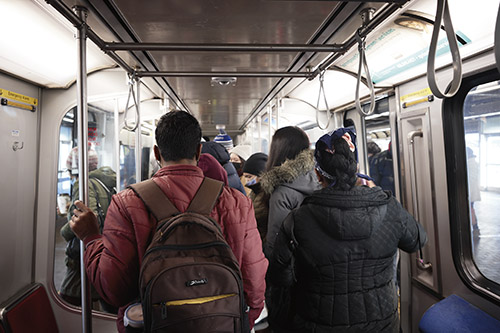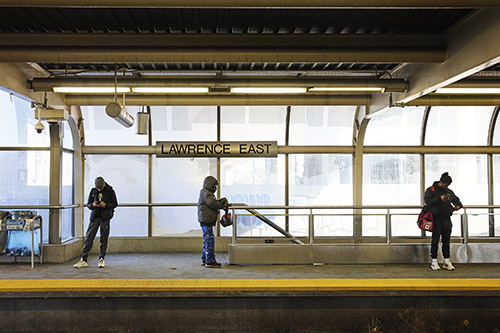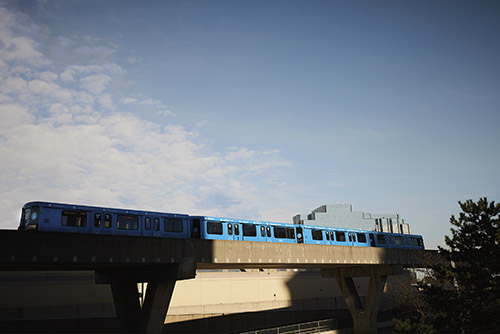 Photography by Ebti Nabag
Photography by Ebti Nabag
End Of The Line
For Scarborough residents, the closure of a major transit system means losing more than a mode of transportation.
The Scarborough RT is screaming. The small rapid transit train has traversed more or less the same route, from McCowan to Kennedy station in the city’s east end, since it opened in 1985. But now, after decades of wear, its six-stop journey is accompanied by a discordant clatter and shriek of metal scraping against metal—the eerily organic wail of a transit lifeline pushed past its limit.
From inside one of the four blue cars, it’s difficult to hear the music coming from my earphones, let alone carry a conversation. A first-time rider might find this intolerable; for upwards of thirty-five thousand daily riders, the pre-pandemic norm, it’s entirely mundane. The sound may be a small price to pay for the sole train tethering them to the rest of Toronto’s subway map.
The RT has long served as a vital bridge for residents of Scarborough, a district that’s home to over six hundred thousand people (almost a quarter of the entire city’s population). “The RT was always my gateway,” says Zain Khurram, who began volunteering with the transit advocacy group TTCriders while he was still in high school. Now a first-year urban planning student at the University of Waterloo, he lives and commutes in Scarborough for half the week.
Khurram has seen the RT as a source of opportunity since he was fourteen. It took him to the glamour and excitement of a downtown core unfurling with possibilities. He and his friends would board the line, brimming with excitement, ready for the short trip down to the subway. “It’s freeing, sort of like it gave you power as a young kid,” he says. For a Scarborough teenager with a transit pass, this journey is the quintessential first taste of independence. It opens up access to the local mall, and makes quick work of the coveted trip downtown.
In 2023, this gateway will shut unceremoniously as the line closes for good. As signalled by the RT’s death rattle, the line has been an object of urban neglect for many years. In the nearly four decades since it opened, the RT has not been revitalized beyond receiving cosmetic updates. A mishmash of repairs and maintenance has held the train together beyond its twenty-five-year service life, but the decay has been glaringly obvious to commuters. “I really wish that we could have kept it, because this is the first time something like this is happening in the GTA—that we’re regressing in terms of transit,” says Khurram. “And it’s frustrating, it’s emotional.”
Ammar Akhtar has been taking the RT for seventeen years. Like Khurram, he saw it as a “lifeline,” ushering him downtown for university, work, and to explore his own community. But he’s long been familiar with the line’s challenges. “Sometimes the RT wouldn’t work,” he says. “Especially when there were snowstorms, or just because it broke down.” For years, Toronto Transit Commission (TTC) reports have documented the corroded brakes, weathered tracks and, according to one CTV investigation, doors on the verge of separating from the train cars. In 2017, one alarmed rider tweeted a photo showing that parts of the train were literally being held together with duct tape.
Since then, it’s become clear to Scarborough residents that the loss of the RT is an inevitability. This realization has given community members and activists time to campaign for a replacement. And yet, the pleas of transit riders have gone unheard by policymakers. Despite Ontario premier Doug Ford touting the Ontario Line subway project as one of his core platform promises during the 2022 provincial election, riders have learned the hard way that the provincial government’s long-promised Scarborough subway is a distant dream—still a decade away.
In the meantime, locals will be forced to rely on a patchwork of unconfirmed replacement bus routes, heralding painfully unrecognizable daily commutes. How are the tens of thousands of daily riders—newcomers, students, professionals, and families—meant to accept such a loss?

Maps of the Toronto subway are iconic. Riding the train, you might see a group of teenagers clamber up and slide the glossy printed map from its place behind a pane of glass at the top of the car. In high school, I remember seeing them pinned to the walls of bedrooms, a coming-of-age trophy of urban exploration. On those maps, the RT is a bright blue line: the only train service that extends into Scarborough.
For it to be erased next year is a profound anomaly. Usually when a train is built, it becomes part of the fabric of the city. “It’s actually very rare in the history of cities for major transit lines to be decommissioned,” says Andre Sorensen, a professor at the University of Toronto Scarborough (UTSC) department of human geography. “People get used to using that infrastructure, and big buildings are built where people are relying on it.”
Why here, of all places, for such a rarity to manifest? Scarborough relies heavily on its existing transit offerings. Historically, it’s been given a familiar and disparaging nickname: Scarberia. Largely home to immigrants and people of colour, with an average household income 30 percent lower than that of Toronto as a whole, the region has long been on the receiving end of inequity and stigma. Those most affected by the loss of the RT will be the people who have nowhere else to turn.
Some neighbourhoods in the region are deemed transit deserts, with up to twenty-minute walks to reach bus stops and stations. Data analysis by the Discourse noted that every area in Scarborough has lower levels of transit access than the Toronto average, with some areas up to three times worse. Using a system by the University of Toronto’s Martin Prosperity Institute that scored neighbourhoods based on their access to transit, the Discourse found that Scarborough had an average score of 20.97, compared to the City of Toronto’s average score of 66.5. The city’s average exceeded the score of every single neighbourhood in Scarborough.
The problem doesn’t end with transit. Advocacy groups have long spoken out about the lack of government-funded community centres, social services, and public health services in Scarborough, all of which contribute to overall inequity in quality of life. A recent campaign by the Scarborough Health Network (SHN) called Love, Scarborough asked why the region makes up a quarter of the city’s population, but receives less than one percent of hospital donations. In 2021, the SHN reported that it had more patients in its intensive care units for Covid-19 than any other hospital network in the province. Hospital executives noted the disproportionate rates of Covid in Scarborough and the fact that the antiquated hospitals in the network made caring for these patients more difficult.
Sultan Khan is a graduate of UTSC, and relied on the RT to shave twenty minutes off his daily commute to school. Now, he rides the RT to work, and says that he’ll have to find a new way to get there after it’s gone. Without the line, Khan will have to wake up earlier every day. He’s had to take shuttle buses on days when the RT was down, and is now prepared for the daily trips on full-time replacement buses that he’s seen get bogged down by traffic. In the summer, roads are clogged with maintenance work, and he thinks of how his formerly unhindered commute will now head straight through gridlock.
There are other, faster routes that can take someone from Scarborough to downtown, or bridge gaps in the subway map. But these GO Transit buses and trains cost extra on top of the TTC fare, and will more than double the total cost of a trip. These barriers are especially challenging for students who already keep tight budgets to pay back their loans. And Khan worries about students who go to Centennial College or UTSC and won’t be able to afford the pricier alternatives, like increased transit fare, cabs, Ubers, or car ownership.
Khan began volunteering last year to pass out flyers with TTCriders. In 2021, the group surveyed RT riders, crowdsourcing community solutions for the RT replacement. But in seeking to address the lack of a concrete solution, their work revealed another issue: most residents still had no idea that the line was closing. Sixty-three percent of those surveyed were unaware of the RT’s impending fate and the disruption it will likely pose to their lives. The group concluded that more and better multilingual advertising of the shutdown was necessary from the TTC immediately.
“This was such a wide, vital service. It has its flaws, but so many people depend on it,” says Khurram. “A lot of people were shocked that something like this could ever happen …they always assumed, ‘Oh, we’re going to get the light rail transit here, it’s going to get extended,’ because that’s what politicians were telling them for decades now. And that’s what they believed.”

Scarborough has long been on the receiving end of gleaming promises. A Toronto Star article from March 1985 sings the praises of the new line: “The fully automatic transit system is also a symbol that Scarborough has shed its desolate Scarberia image and is on the way to developing a true ‘downtown’ of its own.” In the same article, then-alderman Marilyn Mushinski described the RT in even more glowing terms: “This will be Scarborough’s yellow brick road,” she stated. “It will pave Scarborough’s streets with gold.”
But beneath the glitter of these promises is something that more closely resembles a laboratory, replete with half-finished experiments and trial runs. “I think there’s always something shinier around the corner,” says Cameron MacLeod, executive director of the transit advocacy group CodeRedTO. Politicians love cutting ribbons, he explains. “But they don’t like paying for existing things. Paying for the existing buses or paying for the existing drivers is a lot less interesting to decision makers than getting to draw a new line on a map and trying to win votes that way.”
MacLeod describes the RT as a beta project which was groundbreaking at the time. The RT was an intermediate capacity transit system, meant to bridge the gap between buses and subways. Smaller and lighter than a full train, it was more economical for the government to build. It also runs on a narrower track, which proved to be part of its undoing—its specialized nature made it harder to replace parts that were breaking down.
The RT was never supposed to stand on its own forever. It was a piece of infrastructure meant to define Scarborough’s rapidly growing downtown area, expected to morph and transform with the needs of the region. Even in the 1985 Star article, then-city controller Frank Faubert discussed the plan to extend the RT further into Scarborough to Malvern. He worried about what would happen if the line was never extended: “The RT line would then become an orphan link,” he told the Star. “That’s the danger.” But while Scarborough’s population grew rapidly, the RT never did.
The major promise on the table in recent years was a plan optimistically named Transit City. Proposed in 2007, it would have upgraded and expanded the Scarborough RT in tandem with seven proposed light rail transit (LRT) lines throughout the city. Most importantly for Scarborough, it promised to head thirteen kilometres deeper into the region, where the current six-stop RT barely scratches the surface. The proposed Scarborough-Malvern LRT and Sheppard East LRT would have brought public rail transit all the way to Lake Ontario, bringing access to many of the neighbourhoods that remain transit deserts to this day.
“It was just about to start being constructed. And in 2010, on his first day as mayor, before he was sworn in, Rob Ford declared that Transit City was dead and that it was not going to be built,” says Sorensen. Instead, Ford called for the construction of a new subway extension plan that would include Scarborough, part of which he said would be ready in time for the 2015 Pan American Games. Perhaps unsurprisingly, it was never built.
Later, Toronto City Council took the position that Ford did not have the legal authority to scrap the project, as it had already been approved by the council. But by then, the damage was done. It seemed nearly impossible to bring Transit City back online while reconciling it with Ford’s new subway plan, and proposals to bridge the gap were met with opposition from Ford at city council. By now, says Sorensen, the rupture of the Transit City plan and its broken promises are ancient history.
Construction is now underway for the subway, which is set to open in 2030. Until then, residents are stuck with the buses. In the fall, ahead of Toronto’s October 2022 municipal election, advocacy groups like TTCriders successfully campaigned to convert the old RT corridor into a dedicated busway, which could help alleviate the increased traffic that will come with the more than sixty new buses being brought onto streets to replace the line. Converting old train tracks takes time, though. While the busway conversion has been confirmed, the TTC says it could take until 2025 to execute it.
During Toronto’s municipal election in October, TTCriders surveyed candidates about their transit promises. Of the six Scarborough ridings, TTCriders found that four of the councillors who were ultimately elected did not respond to the question of whether the candidate would support bus lanes to replace the Scarborough RT. Both Paul Ainslie of Scarborough-Guildwood and Jamaal Myers of Scarborough North, however, pledged to support the bus lanes. Meanwhile, Mayor John Tory failed to answer whether he’d support replacement lanes for the RT.
In the meantime, buses will run exclusively on the streets. “It’s just unacceptable,” says Shelagh Pizey-Allen, the executive director of TTCriders. “Thirty extra minutes a day when someone’s commuted what could already be an hour, an hour and a half each way. It’s stealing people’s time. And the people who are making these decisions and responsible for the mess that we’re in right now, they don’t take transit.”

When I ask Khurram what the RT means to him as a resident of Scarborough, he gets a little emotional. “That little blue train, it brought me to a lot of places. It was my gateway to adventure, I guess, to independence, to freedom,” he says. As a child, he remembers hearing stories about how one day the RT would be extended right to his neighbourhood. “We wouldn’t have to take the bus, right? I kept waiting for that, waiting for that, and it never happened.”
Like so many of the decisions that have bookended Scarborough’s transit governance, the exact date of the RT’s closure is unclear. When that day comes, Khurram says it will be sad not just because of the time lost for commuters, but because it means losing an iconic piece of Scarborough culture. So many of the people I spoke with used descriptions similar to Khurram’s: a gateway, a lifeline, an opening up of the city, of doors that have long been closed to Scarborough’s people.
Behind the curdled history of broken promises and forgotten projects, residents fondly remember the lines the RT stitched into the fabric of the city. Khan recalls the first time he took the train with his brother to Scarborough Town Centre. It felt like this huge mall, and he remembers how fancy it seemed. Akhtar tells me about Lawrence East Station and the doubles and Chinese food and City Fried Chicken he tried along the way. He can still see the vibrant graffiti along the sides of the tracks.
But his favourite part, Akhtar says, doesn’t require leaving the train at all. “The best part about it was the last bit of sunlight you get. Especially during wintertime,” he says. “Right before you get into Kennedy and then go on to darkness.” I’ve been there at dusk and caught that last moment of brilliance. The four little cars are gilded with light, and everything else is cast into sharp relief by the shadows of the gathering night. Just for a moment, it looks like the tracks are paved in gold. ⁂
Sakeina Syed is a writer based in Toronto. She has written for the Toronto Star, the Globe and Mail, the Walrus, Slate and others.





